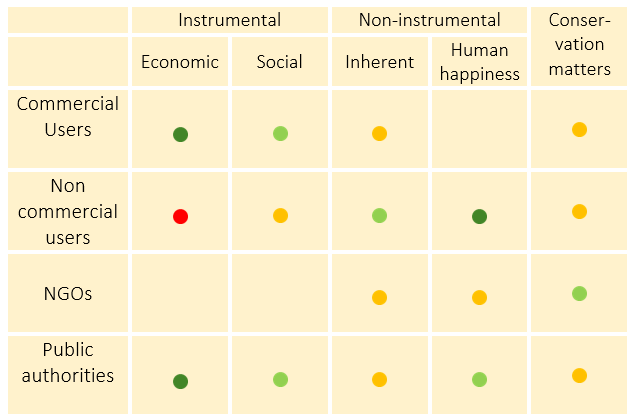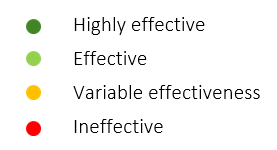![]() Context
Context
Natura 2000 is a network of nature reserves across the European Union. It is designed to protect species and their habitats. Managing the network so that its nature can continue to flourish and be enjoyed comes at a cost, for instance to restore particular habitats which support breeding birds or to maintain hiking paths and information panels for visitors. There are also indirect costs: many Natura 2000 sites have to deal with conflicting socio-economic interests of various stakeholders, including farmers, conservationists, public authorities, or visitors. They mostly have diverging visions on the use of Natura 2000 sites. Bringing these stakeholders around the table to make a convincing case for nature protection is always a challenge.
Our case study analysed different Life projects to find out what arguments work best to convince different stakeholders with an interest in a Natura 2000 site. Life is a fund of the European Commission to support restoration activities in Natura 2000 sites [1].
We first carried out an initial screening of 365 Life projects (covering all EU countries except Croatia) and recorded the arguments that were used in project summary sheets. This analysis yielded first insights on which arguments project managers expected to be effective (see Arguments). In addition, the results were used to guide the subsequent in-depth interviews with LIFE project managers to test the effectiveness of the arguments. In total 55 project managers were requested to participate in the study. Out of these 14 responded and attended the interviews. The in-depth interviews aimed at exploring the perceptions of project managers about the effectiveness of alternative arguments (see Effectiveness).
Arguments
Our study found a rich variety of arguments used to make a case for nature protection in Natura 2000 sites. The inherent argument that nature has a right or value of its own reappeared in almost a third of the of the Life projects included in the first screening phase. People also often underline the importance of conservation without going into detail (10% of the projects screened). Natura 2000 sites are also related to the cultural heritage of a region which is seen as important to protect.
Natura 2000 sites provide multiple ecosystem services which is reflected in the argumentation found in the project summary sheets (14% of the projects used ecosystem services as argumentation). The role of the network in providing cultural ecosystem services, notably recreation and aesthetic values, is used to argue for the conservation of a site. Regulating and provisioning services appear as arguments as well but they are mostly not framed as ecosystem services. An argument which is regularly used is the water regulation capacity of Natura 2000 sites to store water and maintain hydrological functions.
Several projects also stress the importance of Natura 2000 sites for their contribution to the regional economy (5%), and in particular, to help achieve a more sustainable development (7%).
Framing
Our research question about the effectiveness of arguments used to protect and conserve biodiversity in Natura 2000 sites is in essence effect-oriented. We wanted to understand what sort of arguments Life project managers encountered during their contacts with stakeholders and how effective these arguments are in persuading stakeholders.
Therefore, a relatively simple, effect-oriented communication model was chosen to guide the analysis. It is building on the classic understanding of communication as a linear process (also known as Lasswell’s model): Who is communicating which argument under what context to which audience with what effect.
We used two typologies in our study: one for arguments and one for stakeholders. The argument typology was developed by BESAFE scientists. They proposed a hierarchical division of arguments. A first level division separates instrumental arguments from non-instrumental ones. Instrumental arguments refer to use values: protecting nature creates jobs (economic argument) or it provides a source of recreation (social argument). Non-instrumental arguments refer to intrinsic, non-use values: we are morally obliged to protect nature (inherent argument) or it makes us happy.
The stakeholders who are using arguments are grouped into commercial users, non-commercial users, non-governmental organisations and public authorities.
Processes
Establishing a Natura 2000 site and turning it into a functional reserve for threatened habitats and species is a process that takes several years. It can thus be expected that the type of arguments used in Natura 2000 sites changes with implementation process but this was not investigated in our case study.
Effectiveness
Our study found that instrumental and non-instrumental arguments were very differently perceived by each stakeholder group. Instrumental arguments appeared particularly effective for commercial users, where economic interests stood against the conservation activities. But also stakeholders without commercial interest tended to be more receptive to arguments that implied a benefit for themselves or their communities, such as recreation or a cultural value. For public services economic arguments can be convincing as well and thus also very effective.
Overall the study showed a mixed picture, where different individuals among the same stakeholder group could be persuaded by very different arguments (Figure 1). This implies that a mixed argumentation strategy may be optimal in most cases.
Regarding ecosystem services this study found that they should be understood as an addition to the category of instrumental arguments. Where pure economic factors were not sufficient to create a business case for conservation, ecosystem services were frequently applied to make the case for conservation stronger. Besides economic arguments ecosystem services were in fact one of the most frequently used instrumental argument.
Figure 1. Summary of effectiveness of the argument types per stakeholder group based on 14 interviews. The empty cells indicate combinations that were not encountered in our study.
However, the study also showed that at the local scale ecosystem services are perceived as a relatively abstract concept. While the services provided by an ecosystem were frequently used to persuade stakeholders, they were in most cases not framed under the term ecosystem services. This can either mean that the concept is perceived as too academic for local stakeholder, or that project managers themselves did not realize that their arguments referred ecosystem services.
The socio-economic context appeared to have an impact on the effectiveness of arguments. Several cases gave suggestive evidence of the importance of the relationship to nature or the species in question in explaining the effect that an argument had on stakeholder groups. In Life projects where the project developer reported that a stakeholder group had a solid knowledge or an emotional connection to the natural environment in question, it seemed that intrinsic arguments were more effective. However, where there was no strong previous relationship with nature, several project managers reported to have succeeded in fostering such an understanding through activities that made stakeholders engage with and in nature, e.g. through guided tours.
Transferability
This study involved a variety of different countries and contexts across the European Union, and addressed the broader reactions within Natura 2000 argumentation. Thus many of the findings are generalizable and transferable to other situations. For example, the study provides insights into the question of the degree to which instrumental arguments are ultimately replace non-instrumental, ethically motivated arguments. The findings indicate that the moral base of biodiversity conservation is usually an accepted paradigm with which stakeholders do not generally disagree. However, the acceptance of this norm was in most cases not sufficient to motivate action against economic interests. In these cases instrumental arguments came into play to create a business case. Instrumental arguments, including ecosystem services, are hence not replacing but adding to non-instrumental arguments to guarantee political feasibility.
Also, our study found that a consensus-seeking approach is a key factor in achieving any conservation at all. Although a consensus based approach changes the actual socio-economic and ecological outcome of a project, it does signal to the different stakeholders a certain degree of influence over policy outcomes and thus, can help to create trust. Hence, consensus-seeking practices should also be understood as one of the mediating factors for stakeholder persuasion.
Lesson learned
- The argument strategy should always consist of a mix of instrumental and non-instrumental arguments, as only focusing on instrumental arguments might repel those individuals that see a strong ethical motivation.
- Instrumental arguments are particularly important where conservation action stands against the self-interest of the stakeholder, i.e. for stakeholders that use the ecosystem commercially.
- For non-commercial users of the ecosystem (e.g. local population or recreational users) arguments that refer to social benefits might be most convincing. For instance, once can refer to values of recreation or cultural landscapes.
- Ecosystem services can be used as addition to economic arguments to make a business case for conservation or to add a more practical dimension to a purely ethical argumentation.
- A consensus-seeking approach between stakeholders is a key factor in achieving any conservation at all and can help to build trust. This requires good communication skills of project managers who have to bring stakeholders around the table.
Reference
[1] European Commission
http://ec.europa.eu/environment/life/
Looking for more information on effective arguments for biodiversity?
For more BESAFE results, including separate briefs focusing on other case studies and various aspects of argumentation, see http://www.besafe.pensoft.net [ref BESAFE toolkit].
This brief is a result of research carried out under the BESAFE project. This brief was written by Joachim Maes, Joint Research Centre (Ispra, Italy).
The BESAFE project is an interdisciplinary research project funded under the European Community’s Seventh Framework Programme, contract number: 282743.
http://www.besafe.pensoft.net/ | joachim.maes@jrc.ec.europa.eu


